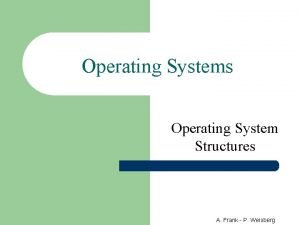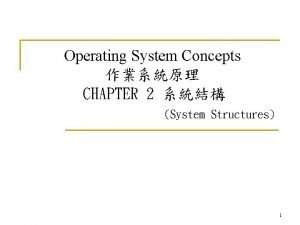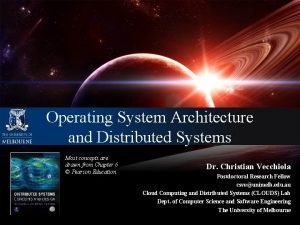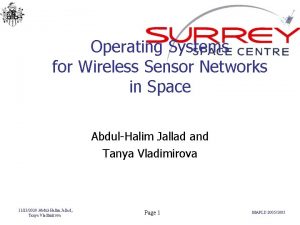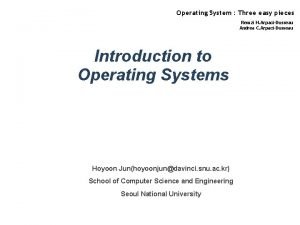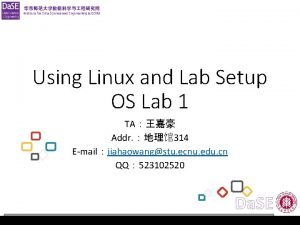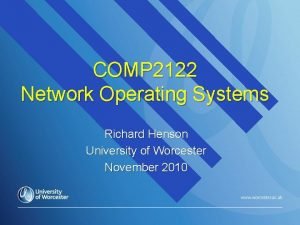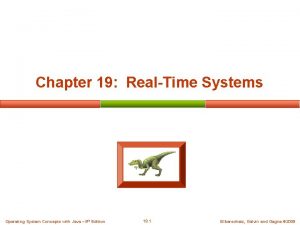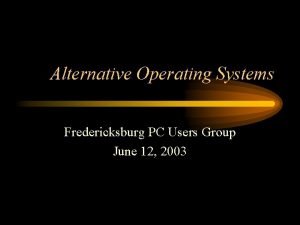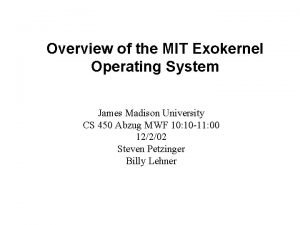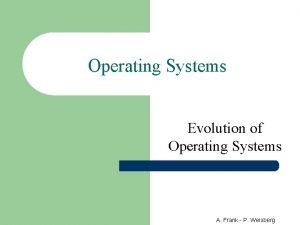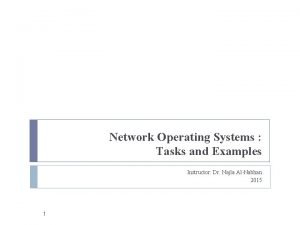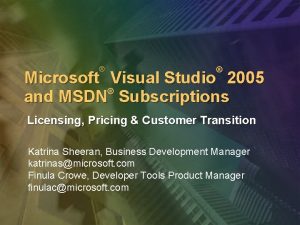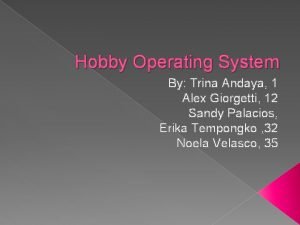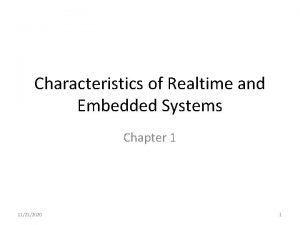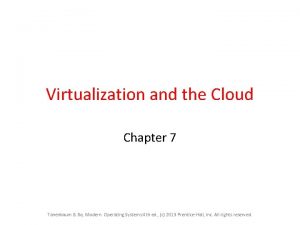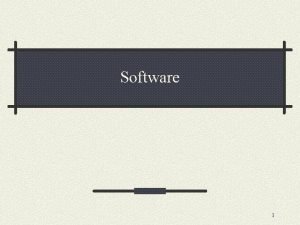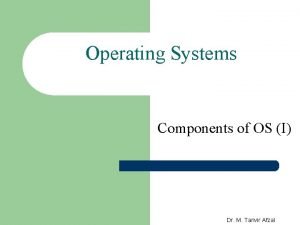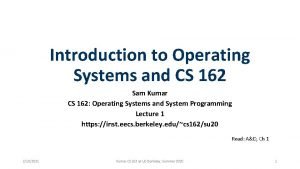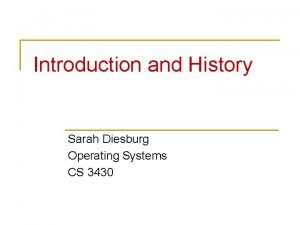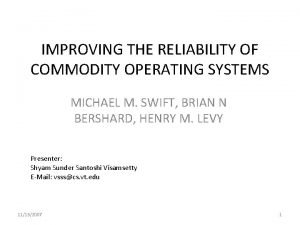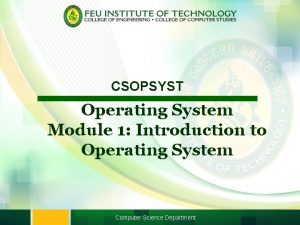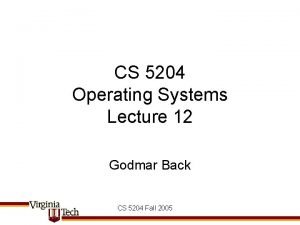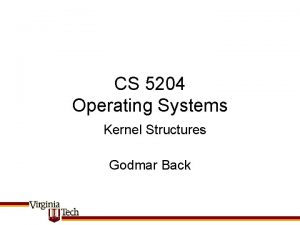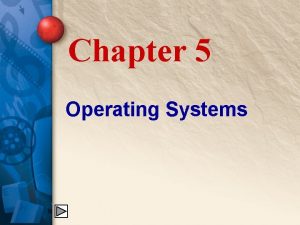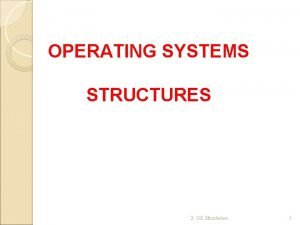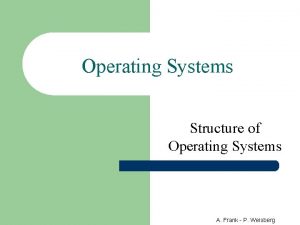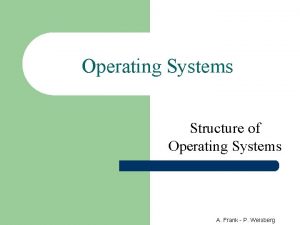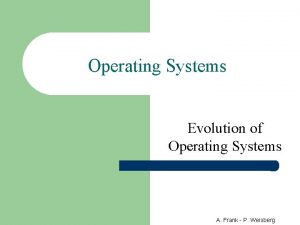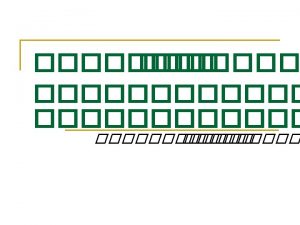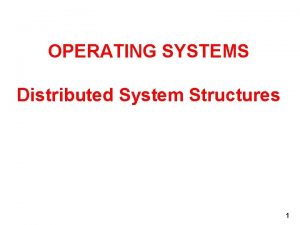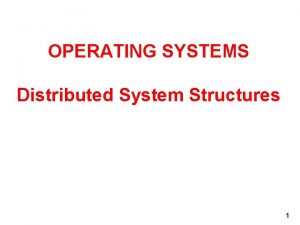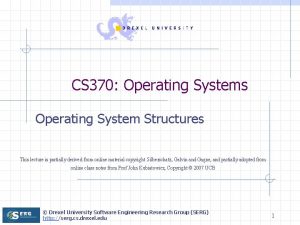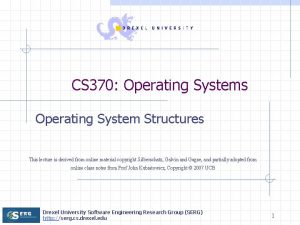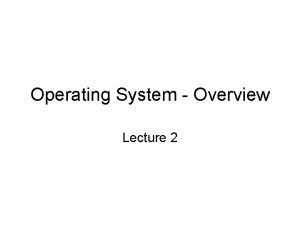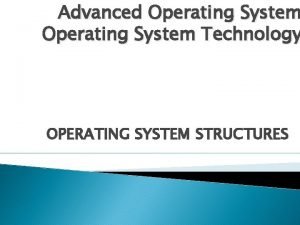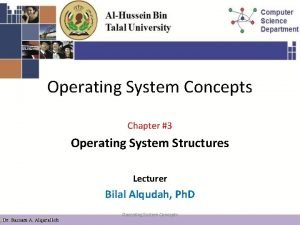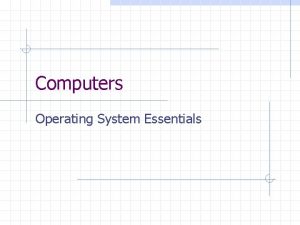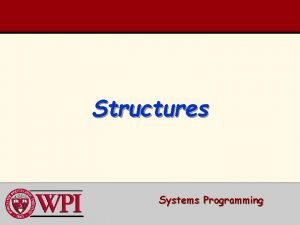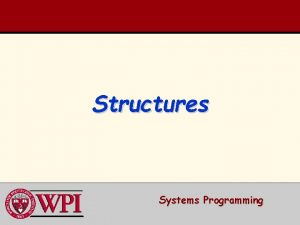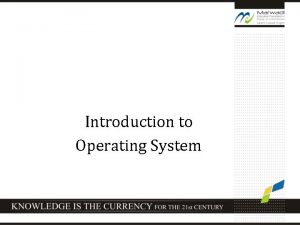Operating Systems Operating System Structures A Frank P













































- Slides: 45

Operating Systems Operating System Structures A. Frank - P. Weisberg

Operating System Structures • • • 2 Operating System Services Common System Components System Calls and APIs System Programs System Design and Implementation System Pragmatics A. Frank - P. Weisberg

A View of Operating System Services 3 A. Frank - P. Weisberg

OS Services (user-oriented) 4 • Program execution – OS capability to load a program into memory, run it, end execution, either normally or abnormally (indicating error). • I/O operations – since user programs cannot execute I/O operations directly, the OS must provide some means to perform I/O, which may involve a file or I/O device. • File systems – program capability to read, write, create, and delete files and directories. • Communication – Processes may exchange information, on the same computer or between computers over a network – Implemented via shared memory or message passing. • Error detection – ensure correct computing by detecting errors in the CPU and memory hardware, in I/O devices, or in user programs. A. Frank - P. Weisberg

Communication Models • Communication may take place using either (a) message passing or (b) shared memory. 5 A. Frank - P. Weisberg

OS Services (system-oriented) 6 • Resource allocation – When multiple users or multiple jobs running concurrently, resources must be allocated to each of them. • Accounting – To keep track of which users use how much and what kinds of computer resources • Protection and security – The owners of information stored in a multi-user or networked computer system may want to control use of that information, while concurrent processes should not interfere with each other – If a system is to be protected and secure, precautions must be instituted throughout it; a chain is only as strong as its weakest link. A. Frank - P. Weisberg

Common System Components • • 7 Process Management Main Memory Management Storage/File System Management I/O System Management Mass-Storage Management Networking Command Interpreter Protection and Security A. Frank - P. Weisberg

Process Management (1) • A process is a program in execution. It is a unit of work within the system. • Program is a passive entity, process is an active entity. • The operating system is responsible for the following activities in connection with process management: – – – 8 Creating and deleting both user and system processes. Suspending and resuming processes. Providing mechanisms for process synchronization. Providing mechanisms for process communication. Providing mechanisms for deadlock handling. A. Frank - P. Weisberg

Process Management (2) • A Process needs resources to accomplish its task: – CPU, memory, I/O devices, files – Initialization data • Process termination requires reclaim of any reusable resources. • Single-threaded process has one program counter specifying location of next instruction to execute – Process executes instructions sequentially, one at a time, until completion. • Multi-threaded process has one program counter per thread. • Typically a system has many processes, some user, some operating system running concurrently on one or more CPUs 9 – Concurrency by multiplexing the CPUs among the processes/threads. A. Frank - P. Weisberg

Main Memory Management • To execute a program all (or part) of the instructions must be in memory. • All (or part) of the data that is needed by the program must be in memory. • Memory management determines what is in memory and when – Optimizing CPU utilization and computer response to users. • Memory management activities: – Keeping track of which parts of memory are currently being used and by whom. – Deciding which processes (or parts thereof) and data to move into and out of memory. – Allocating and de-allocating memory space as needed. 10 A. Frank - P. Weisberg

Storage/File System Management • A file is a collection of related information. • Commonly, files represent programs (both source and object forms) and data. • Files are usually organized into directories. • Access control on most file systems to determine who can access what. • OS activities include: 11 – – Creating and deleting files and directories. Primitives to manipulate files and directories. Mapping files onto secondary storage. Backup files onto stable (non-volatile) storage media. A. Frank - P. Weisberg

I/O System Management • One purpose of OS is to hide peculiarities of hardware devices from the user. • I/O subsystem is responsible for: 12 – Memory management of I/O including buffering (storing data temporarily while it is being transferred), caching (storing parts of data in faster storage for performance), spooling (the overlapping of output of one job with input of other jobs). – General device-driver interface. – Drivers for specific hardware devices. A. Frank - P. Weisberg

Mass-Storage Management • Usually disks used to store data that does not fit in main memory or data that must be kept for a “long” period of time. • Proper management is of central importance. • Entire speed of computer operation hinges on disk subsystem and its algorithms. • OS activities: – Free-space management – Storage allocation – Disk scheduling • Some storage need not be fast: 13 – Tertiary storage includes optical storage, magnetic tape – Varies between WORM (write-once, read-many-times) and RW (readwrite) A. Frank - P. Weisberg

Networking • The processors in the system are connected through a communication network. • Communication takes place using a protocol. • A networked/distributed system provides user access to various system resources. • Access to a shared resource allows: – Computation speed-up – Increased data availability – Enhanced reliability 14 A. Frank - P. Weisberg

Command Interpreter • Command-Interpreter: – The program that reads and executes commands given to the operating system. – Examples of command-line interpreters are command. com (DOS), shell (UNIX). – In windows systems the interface is mouse and menu based – WIMP (Windows, Icons, Menu, and Pointing device). 15 A. Frank - P. Weisberg

Graphical User Interface (GUI) • User-friendly desktop metaphor interface: – Usually mouse, keyboard, and monitor. – Icons represent files, programs, actions, etc. – Various mouse buttons over objects in the interface cause various actions (provide information, options, execute function, open folder). – Invented at Xerox PARC. • Systems now include both CLI and GUI interfaces: – Microsoft Windows is GUI with CLI “command” shell. – Apple Mac OS X as “Aqua” GUI with UNIX kernel underneath and shells available. – Solaris is CLI with optional GUIs (Java Desktop, KDE). 16 A. Frank - P. Weisberg

Protection and Security • Protection – any mechanism for controlling access of processes or users to both system and user resources. • Security – defense of the system against internal and external attacks, with huge range, including: – – – 17 Denial-of-service Worms Viruses Identity theft Theft of service. A. Frank - P. Weisberg

Protection Aspects • Systems generally first distinguish among users, to determine who can do what: – User identities (user IDs, security IDs) include name and associated number, one per user. – User ID then associated with all files, processes of that user to determine access control. – Group identifier (group ID) allows set of users to be defined and controls managed, then also associated with each process, file. – Privilege escalation allows user to change to effective ID with more rights. 18 A. Frank - P. Weisberg

Error Detection/Response • Error Detection • Error Response – internal and external hardware errors • memory error • device failure – software errors • arithmetic overflow • access forbidden memory locations 19 A. Frank - P. Weisberg – simply report error to the application – Retry the operation – Abort the application

Accounting • Accounting keeps track of and records which users use how much and what kinds of computer resources. • Accounting: – collect statistics on resource usage – monitor performance (e. g. , response time) – used for system parameter tuning to improve performance – useful for anticipating future enhancements – used for billing users (on multi-user systems) 20 A. Frank - P. Weisberg

System Calls and APIs • • Systems calls provide programming interface to the services provided by the OS. Typically written in a high-level language (C/C++). Mostly accessed by programs via a high-level Application Program Interface (API) rather than through direct system calls. Three most common APIs: 1. Win 32 API for Windows 2. POSIX API for POSIX-based systems (including virtually all versions of UNIX, Linux, and Mac OS X) 3. Java API for the Java Virtual Machine (JVM) 21 A. Frank - P. Weisberg

Example of System Call 22 A. Frank - P. Weisberg

Example of Standard API • Consider the Read. File() function in the Win 32 API – a function for reading from a file 23 • Ø Ø Ø A description of the parameters passed to Read. File() HANDLE file – the file to be read LPVOID buffer – a buffer where the data will be read into and written from DWORD bytes. To. Read – the number of bytes to be read into the buffer LPDWORD bytes. Read – the number of bytes read during the last read LPOVERLAPPED ovl – indicates if overlapped I/O is being used

System Call Implementation • Typically, a number is associated with each system call – System-call interface maintains a table indexed according to these numbers. • The system call interface invokes intended system call in kernel and returns status of the system call and any return values. • The caller need know nothing about how the system call is implemented: – Just needs to obey API and understand what OS will do as a result call. – Details of OS interface hidden from programmer by API since managed by run-time support library (set of functions built into libraries included with compiler). 24 A. Frank - P. Weisberg

API – System Call – OS Relationship 25 A. Frank - P. Weisberg

Standard C Library Example • C program invoking printf() library call, which calls write() system call. 26 A. Frank - P. Weisberg

System Call Parameter Passing • • • 27 Often, more information is required than simply identity of desired system call, but exact type and amount of information vary according to OS and call. Three general methods used to pass parameters to the OS: 1. Simplest: pass the parameters in registers • In some cases, may be more parameters than registers. 2. Parameters stored in a block, or table, in memory, and address of block passed as a parameter in a register • This approach taken by Linux and Solaris. 3. Parameters placed, or pushed, onto the stack by the program and popped off the stack by the operating system. Block and stack methods do not limit the number or length of parameters being passed. A. Frank - P. Weisberg

Parameter Passing via Table 28 A. Frank - P. Weisberg

Parameter Passing via Stack 29 The 11 steps in making the system call read(fd, buffer, nbytes) A. Frank - P. Weisberg

Examples of POSIX System Calls 30 A. Frank - P. Weisberg

System Calls for File Management (POSIX) 31 A. Frank - P. Weisberg

Examples of Windows and Unix System Calls 32

Win 32 API calls roughly correspond to UNIX calls 33 A. Frank - P. Weisberg

System Programs (1) • System programs provide a convenient environment for program development and execution: – File management/modification, Status information, Programming language support, Program loading and execution, Communications, Application programs • Most users’ view of the operating system is defined by system programs, not the actual system calls. • Provide a convenient environment for program development and execution: – Some of them are simply user interfaces to system calls; others are considerably more complex. 34 A. Frank - P. Weisberg

System Programs (2) • File management – create, delete, copy, rename, print, dump, list, and others generally manipulate files and directories. • Status information: – Some ask the system for information – date, time, amount of available memory, disk space, number of users. – Others provide detailed performance, logging, and debugging information. – Typically, these programs format and print the output to the terminal or other output devices. – Some systems implement a registry – used to store and retrieve configuration information. 35 A. Frank - P. Weisberg

System Programs (3) • File modification: – Text editors to create and modify files – Special commands to search contents of files or perform transformations of the text. • Programming language support – compilers, assemblers, debuggers and interpreters sometimes provided. • Program loading and execution – absolute loaders, relocatable loaders, linkage editors, and overlay loaders, debugging systems for higher-level and machine language. • Communications – Provide the mechanism for creating virtual connections among processes, users, and computer systems: – Allow users to send messages to one another’s screens, browse web pages, send electronic-mail messages, log in remotely, transfer files from one machine to another. 36 A. Frank - P. Weisberg

System Design Goals • Design and Implementation of OS not “solvable”, but some approaches have proven successful. • Internal structure of different OSes can vary widely. • Start by defining goals and specifications. • Affected by choice of hardware, type of system. • User goals and System goals: – User goals – operating system should be convenient to use, easy to learn, reliable, safe, and fast. – System goals – operating system should be easy to design, implement, and maintain, as well as flexible, reliable, error-free, and efficient. 37 A. Frank - P. Weisberg

Separation of Mechanisms and Policies • Important principle to separate: Policy: What will be done? Mechanism: How to do it? • Mechanisms determine how to do something, policies decide what will be done. • The separation of policy from mechanism is a very important principle, it allows maximum flexibility if policy decisions are to be changed later. 38 A. Frank - P. Weisberg

Example: Managing a Queue • Let’s use an abstract priority queue as example. • We need to support mechanisms for: – Insert/Delete items at start. – Insert/Delete items at end. – Know length of queue. • Body/code of queue can be implemented in different ways. • Policies can be for example FIFO, LIFO (or GIGO ) – should be decided by queue user. 39 A. Frank - P. Weisberg

System Implementation • Traditionally written in assembly language, operating systems can now be written in higher-level languages. • Code written in a high-level language: – can be written faster. – is more compact. – is easier to understand debug. • An OS is far easier to port (move to some other hardware) if it is written in a high-level language. 40 A. Frank - P. Weisberg

Open-Source Operating Systems • Operating systems made available in sourcecode format rather than just binary closedsource. • Counter to the copy protection and Digital Rights Management (DRM) movement. • Started by Free Software Foundation (FSF), which has “copyleft” GNU Public License (GPL). • Examples include GNU/Linux, BSD UNIX (including core of Mac OS X), and many more. 41 A. Frank - P. Weisberg

Operating System Debugging (1) 42 • Debugging is finding and fixing errors, or bugs. • OSs generate log files containing error information. • Failure of an application can generate core dump file capturing memory of the process. • Operating system failure can generate crash dump file containing kernel memory. • Beyond crashes, performance tuning can optimize system performance. A. Frank - P. Weisberg

Operating System Debugging (2) • Kernighan’s Law: “Debugging is twice as hard as writing the code in the first place. Therefore, if you write the code as cleverly as possible, you are, by definition, not smart enough to debug it. ” • DTrace tool in Solaris, Free. BSD, Mac OS X allows live instrumentation on production systems – Probes fire when code is executed, capturing state data and sending it to consumers of those probes. 43 A. Frank - P. Weisberg

Operating System Generation • Operating systems are designed to run on any of a class of machines; the system must be configured for each specific computer site. • SYSGEN (System Generation) program obtains information concerning the specific configuration of the hardware system. • Booting – starting a computer by loading the kernel • Bootstrap program – code stored in ROM that is able to locate the kernel, load it into memory, and start its execution 44 A. Frank - P. Weisberg

System Boot • Operating system must be made available to hardware so the hardware can start it: – Small piece of code – bootstrap loader/program, locates the OS kernel, loads it into memory, and starts execution. – Sometimes two-step process where boot block at fixed location loads bootstrap loader. – Typically stored in ROM or EPROM, generally known as firmware. – When power-up or reboot, execution of bootstrap program starts at a fixed memory location. – Initializes all aspects of system. 45 A. Frank - P. Weisberg
 Operating system structure
Operating system structure Operating-system structures
Operating-system structures Frank william abagnale
Frank william abagnale Homologous structure
Homologous structure Os architecture
Os architecture Buddy system memory
Buddy system memory File system in operating system
File system in operating system File system in operating system
File system in operating system File system in operating system
File system in operating system Define operating system
Define operating system Evolution of operating systems
Evolution of operating systems Components of operating systems
Components of operating systems Component of operating systems
Component of operating systems Wsn operating systems
Wsn operating systems Operating system 3 easy pieces
Operating system 3 easy pieces Operating system lab
Operating system lab Introduction to operating systems
Introduction to operating systems Tanenbaum os
Tanenbaum os Components of operating systems
Components of operating systems Design issues in distributed systems
Design issues in distributed systems Early operating systems
Early operating systems Real-time operating systems
Real-time operating systems Can we make operating systems reliable and secure
Can we make operating systems reliable and secure Alternative operating systems
Alternative operating systems Operating systems mit
Operating systems mit Operating system internals and design principles
Operating system internals and design principles Operating system evolution
Operating system evolution Network operating system example
Network operating system example Visual studio 2005 team suite
Visual studio 2005 team suite Hobbyist operating system
Hobbyist operating system Characteristics of real time embedded system
Characteristics of real time embedded system Operating systems
Operating systems Operating system chapter 1 notes
Operating system chapter 1 notes Layers of operating system
Layers of operating system System software is divided into how many parts
System software is divided into how many parts Components of os
Components of os Module 4 operating systems and file management
Module 4 operating systems and file management Modern operating systems 3rd edition
Modern operating systems 3rd edition Uc berkeley operating systems
Uc berkeley operating systems Operating systems
Operating systems Improving the reliability of commodity operating systems
Improving the reliability of commodity operating systems Dual mode in os
Dual mode in os Operating systems
Operating systems Operating systems
Operating systems Modern operating systems tanenbaum 5th edition
Modern operating systems tanenbaum 5th edition What are 5 operating systems
What are 5 operating systems
